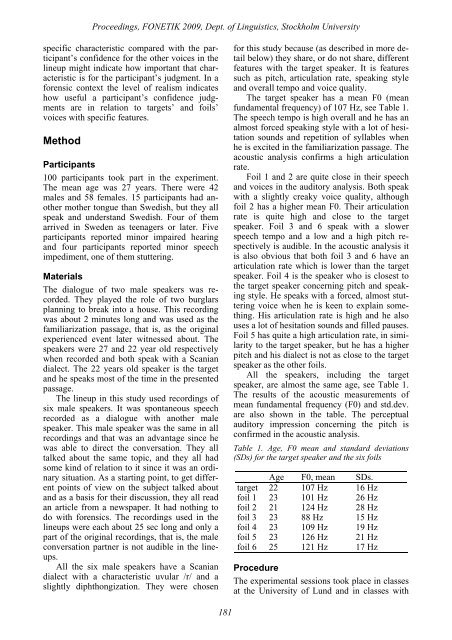Proceedings Fonetik 2009 - Institutionen för lingvistik
Proceedings Fonetik 2009 - Institutionen för lingvistik
Proceedings Fonetik 2009 - Institutionen för lingvistik
Create successful ePaper yourself
Turn your PDF publications into a flip-book with our unique Google optimized e-Paper software.
<strong>Proceedings</strong>, FONETIK <strong>2009</strong>, Dept. of Linguistics, Stockholm Universityspecific characteristic compared with the participant’sconfidence for the other voices in thelineup might indicate how important that characteristicis for the participant’s judgment. In aforensic context the level of realism indicateshow useful a participant’s confidence judgmentsare in relation to targets’ and foils’voices with specific features.MethodParticipants100 participants took part in the experiment.The mean age was 27 years. There were 42males and 58 females. 15 participants had anothermother tongue than Swedish, but they allspeak and understand Swedish. Four of themarrived in Sweden as teenagers or later. Fiveparticipants reported minor impaired hearingand four participants reported minor speechimpediment, one of them stuttering.MaterialsThe dialogue of two male speakers was recorded.They played the role of two burglarsplanning to break into a house. This recordingwas about 2 minutes long and was used as thefamiliarization passage, that is, as the originalexperienced event later witnessed about. Thespeakers were 27 and 22 year old respectivelywhen recorded and both speak with a Scaniandialect. The 22 years old speaker is the targetand he speaks most of the time in the presentedpassage.The lineup in this study used recordings ofsix male speakers. It was spontaneous speechrecorded as a dialogue with another malespeaker. This male speaker was the same in allrecordings and that was an advantage since hewas able to direct the conversation. They alltalked about the same topic, and they all hadsome kind of relation to it since it was an ordinarysituation. As a starting point, to get differentpoints of view on the subject talked aboutand as a basis for their discussion, they all readan article from a newspaper. It had nothing todo with forensics. The recordings used in thelineups were each about 25 sec long and only apart of the original recordings, that is, the maleconversation partner is not audible in the lineups.All the six male speakers have a Scaniandialect with a characteristic uvular /r/ and aslightly diphthongization. They were chosenfor this study because (as described in more detailbelow) they share, or do not share, differentfeatures with the target speaker. It is featuressuch as pitch, articulation rate, speaking styleand overall tempo and voice quality.The target speaker has a mean F0 (meanfundamental frequency) of 107 Hz, see Table 1.The speech tempo is high overall and he has analmost forced speaking style with a lot of hesitationsounds and repetition of syllables whenhe is excited in the familiarization passage. Theacoustic analysis confirms a high articulationrate.Foil 1 and 2 are quite close in their speechand voices in the auditory analysis. Both speakwith a slightly creaky voice quality, althoughfoil 2 has a higher mean F0. Their articulationrate is quite high and close to the targetspeaker. Foil 3 and 6 speak with a slowerspeech tempo and a low and a high pitch respectivelyis audible. In the acoustic analysis itis also obvious that both foil 3 and 6 have anarticulation rate which is lower than the targetspeaker. Foil 4 is the speaker who is closest tothe target speaker concerning pitch and speakingstyle. He speaks with a forced, almost stutteringvoice when he is keen to explain something.His articulation rate is high and he alsouses a lot of hesitation sounds and filled pauses.Foil 5 has quite a high articulation rate, in similarityto the target speaker, but he has a higherpitch and his dialect is not as close to the targetspeaker as the other foils.All the speakers, including the targetspeaker, are almost the same age, see Table 1.The results of the acoustic measurements ofmean fundamental frequency (F0) and std.dev.are also shown in the table. The perceptualauditory impression concerning the pitch isconfirmed in the acoustic analysis.Table 1. Age, F0 mean and standard deviations(SDs) for the target speaker and the six foilsAge F0, mean SDs.target 22 107 Hz 16 Hzfoil 1 23 101 Hz 26 Hzfoil 2 21 124 Hz 28 Hzfoil 3 23 88 Hz 15 Hzfoil 4 23 109 Hz 19 Hzfoil 5 23 126 Hz 21 Hzfoil 6 25 121 Hz 17 HzProcedureThe experimental sessions took place in classesat the University of Lund and in classes with181
















